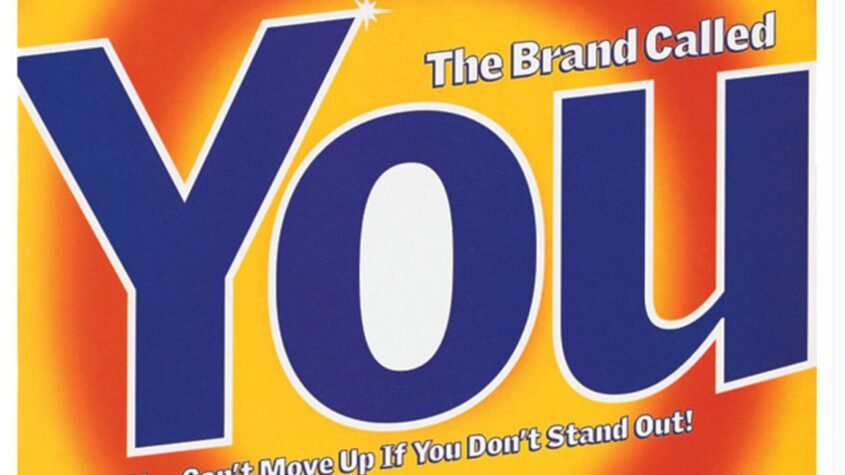
The Brand Called You
It’s a new brand world.
That cross-trainer you’re wearing — one look at the distinctive swoosh on the side tells everyone who’s got you branded. That coffee travel mug you’re carrying — ah, you’re a Starbucks woman! Your T-shirt with the distinctive Champion “C” on the sleeve, the blue jeans with the prominent Levi’s rivets, the watch with the hey-this-certifies-I-made-it icon on the face, your fountain pen with the maker’s symbol crafted into the end …
You’re branded, branded, branded, branded.
It’s time for me — and you — to take a lesson from the big brands, a lesson that’s true for anyone who’s interested in what it takes to stand out and prosper in the new world of work.
Regardless of age, regardless of position, regardless of the business we happen to be in, all of us need to understand the importance of branding. We are CEOs of our own companies: Me Inc. To be in business today, our most important job is to be head marketer for the brand called You.
It’s that simple — and that hard. And that inescapable.
Behemoth companies may take turns buying each other or acquiring every hot startup that catches their eye — mergers in 1996 set records. Hollywood may be interested in only blockbusters and book publishers may want to put out only guaranteed best-sellers. But don’t be fooled by all the frenzy at the humongous end of the size spectrum.
The real action is at the other end: the main chance is becoming a free agent in an economy of free agents, looking to have the best season you can imagine in your field, looking to do your best work and chalk up a remarkable track record, and looking to establish your own micro equivalent of the Nike swoosh. Because if you do, you’ll not only reach out toward every opportunity within arm’s (or laptop’s) length, you’ll not only make a noteworthy contribution to your team’s success — you’ll also put yourself in a great bargaining position for next season’s free-agency market.
The good news — and it is largely good news — is that everyone has a chance to stand out. Everyone has a chance to learn, improve, and build up their skills. Everyone has a chance to be a brand worthy of remark.
Who understands this fundamental principle? The big companies do. They’ve come a long way in a short time: it was just over four years ago, April 2, 1993 to be precise, when Philip Morris cut the price of Marlboro cigarettes by 40 cents a pack. That was on a Friday. On Monday, the stock market value of packaged goods companies fell by $25 billion. Everybody agreed: brands were doomed.
Today brands are everything, and all kinds of products and services — from accounting firms to sneaker makers to restaurants — are figuring out how to transcend the narrow boundaries of their categories and become a brand surrounded by a Tommy Hilfiger-like buzz.
Who else understands it? Every single Web site sponsor. In fact, the Web makes the case for branding more directly than any packaged good or consumer product ever could. Here’s what the Web says: Anyone can have a Web site. And today, because anyone can … anyone does! So how do you know which sites are worth visiting, which sites to bookmark, which sites are worth going to more than once? The answer: branding. The sites you go back to are the sites you trust. They’re the sites where the brand name tells you that the visit will be worth your time — again and again. The brand is a promise of the value you’ll receive.
The same holds true for that other killer app of the Net — email. When everybody has email and anybody can send you email, how do you decide whose messages you’re going to read and respond to first — and whose you’re going to send to the trash unread? The answer: personal branding. The name of the email sender is every bit as important a brand — is a brand — as the name of the Web site you visit. It’s a promise of the value you’ll receive for the time you spend reading the message.
Nobody understands branding better than professional services firms. Look at McKinsey or Arthur Andersen for a model of the new rules of branding at the company and personal level. Almost every professional services firm works with the same business model. They have almost no hard assets — my guess is that most probably go so far as to rent or lease every tangible item they possibly can to keep from having to own anything. They have lots of soft assets — more conventionally known as people, preferably smart, motivated, talented people. And they have huge revenues — and astounding profits.
They also have a very clear culture of work and life. You’re hired, you report to work, you join a team — and you immediately start figuring out how to deliver value to the customer. Along the way, you learn stuff, develop your skills, hone your abilities, move from project to project. And if you’re really smart, you figure out how to distinguish yourself from all the other very smart people walking around with $1,500 suits, high-powered laptops, and well-polished resumes. Along the way, if you’re really smart, you figure out what it takes to create a distinctive role for yourself — you create a message and a strategy to promote the brand called You.
What makes You different?
Start right now:…

















